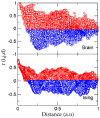Ising-like dynamics in large-scale functional brain networks
- PMID: 19658539
- PMCID: PMC2746490
- DOI: 10.1103/PhysRevE.79.061922
Ising-like dynamics in large-scale functional brain networks
Abstract
Brain "rest" is defined--more or less unsuccessfully--as the state in which there is no explicit brain input or output. This work focuses on the question of whether such state can be comparable to any known dynamical state. For that purpose, correlation networks from human brain functional magnetic resonance imaging are contrasted with correlation networks extracted from numerical simulations of the Ising model in two dimensions at different temperatures. For the critical temperature Tc, striking similarities appear in the most relevant statistical properties, making the two networks indistinguishable from each other. These results are interpreted here as lending support to the conjecture that the dynamics of the functioning brain is near a critical point.
Figures








References
Publication types
MeSH terms
Grants and funding
LinkOut - more resources
Full Text Sources
